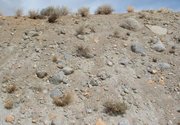Till
|
|
This article is about glacial sediments, for other uses see till (disambiguation).
Till is an unsorted glacial sediment. Glacial drift is a general term for the coarsely graded and extremely heterogeneous sediments of glacial origin. Glacial till is that part of glacial drift which was deposited directly by the glacier. It may vary from clays to mixtures of clay, sand, gravel and boulders. A particularly sticky form of clay till is called gumbo. Clay in till may form balls called till balls. If a till ball rolls around in a stream and picks up rocks from the bed of the stream and becomes covered with them it may become an armored till ball.
Till is deposited at the terminal moraine and along the lateral moraines of a glacier. As a glacier melts, especially a continental glacier large amounts of till are deposited by the rivers flowing from the glacier and in any proglacial lakes which may form. Till may contain alluvial deposits of gems or other valuable ore minerals picked up by the glacier during its advance, for example the diamonds found in Wisconsin, Indiana, and Canada. Prospectors use trace minerals in tills as clues to follow the glacier upstream to find kimberlite diamond deposits and other types of ore deposits.
In cases where the till has been cemented together into solid rock, it is known as tillite. Ancient tillites provided early evidence for continental drift. The same tillites also provide the key evidence for the current Snowball Earth theory.
Types of till
There are various types of classifying tills:
- primary deposits – these were laid down directly by glacier action
- secondary deposits – these have undergone reworking (e.g. fluvial transport, erosion, etc)
Traditionally (e.g. Dreimanis, 1988), a further set of divisions has been made to primary deposits, based upon the method of deposition.
- Lodgement tills – sediment which has been deposited by plastering of glacial debris from a sliding glacier bed.
- Deformation tills – Sediment which has been disaggregated and (usually) homogenised by shearing in the sub glacial deformed layer.
- Melt out tills – Released by melting of stagnant or slowly moving debris-rich glacier ice and deposited without subsequent transport or deformation. Split up into sub glacial melt out till (melting of debris rich ice at the bottom of the glacier) and supraglacial melt-out till (melting of ice on the glacier surface).
- Sublimation till – similar to melt out till, except the ice is lost through sublimation rather than melt. Often only occurs in extremely cold and arid conditions, mainly in Antarctica.
Some (e.g. Van Der Meer et Al. 2003) have suggested that these till classifications are outdated and should instead be replaced with only one classification, that of deformation till. The reasons behind this are largely down to the difficulties in accurately classifying different tills, which are often classified based on inferences of the physical setting of the till rather than till fabric or particle size analysis (PSA) data.

